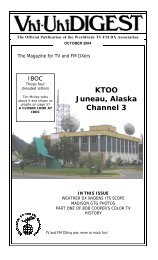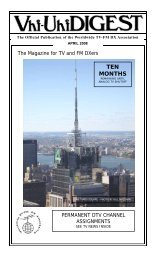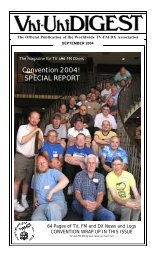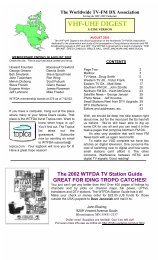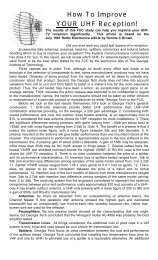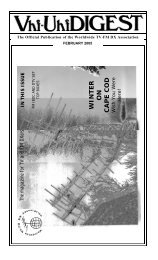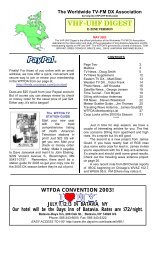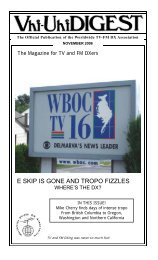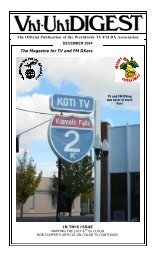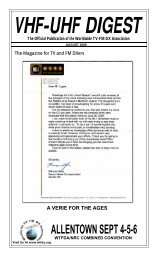VHF-UHF DIGEST - Worldwide TV-FM DX Association
VHF-UHF DIGEST - Worldwide TV-FM DX Association
VHF-UHF DIGEST - Worldwide TV-FM DX Association
- No tags were found...
Create successful ePaper yourself
Turn your PDF publications into a flip-book with our unique Google optimized e-Paper software.
MORE Q & A STUFF YOU ALWAYS WONDERED ABOUTQ. Are there any car radios good for <strong>FM</strong> Dxing?A. As far as aftermarket car radios goes, my experience is that the Sony CA650X, and BlaupunktHeidelberg are the best. I have used other aftermarket car stereos from Kenwood, Clarion, Alpine,and factory from GM, Chrysler, and Hyundai. I currently have the Sony in one vehicle and the Blau inthe other. Both are excellent with adjacent channels, allowing signals to be heard on either side of100kw signals from around 5 miles from the tower. The capture on the Blau is better than the Sony,and the "digituner" technology the Blau uses seems to produce a much cleaner signal overall onweak stations. The Sony tends to be more susceptible to overload if around lots of high poweredsignals, while the Blau will ratchet down sensitivity in the midst of strong signals to compensate. TheSony has the best AM section I've ever used on a car radio. I think the Blau would perform evenbetter if it wasn't in a vehicle with one of those stupid in-glass antennas:(--------------------Q. I was on the roof today checking out my dish. The coax (RG6) is starting to look shabby. It's beenup there a few years. Does coax degrade over time?A. Absolutely! the primary factor seems to be exposure to direct sun. Does signal loss increase?Sure does! There are ample numbers of hams active on <strong>VHF</strong> who could attest to that, including yourstruly. As the outer coating wears, so does the dielectric inside which separates the conductor fromthe shield.--------------------Q. I believe that all the new D<strong>TV</strong> stations are on channels 7-69. Last night, a CA<strong>TV</strong> engineer told methat all these new D<strong>TV</strong> stations would eventually be on <strong>UHF</strong>, and that 174-216 Mhz will be realocatedto digital land mobile. Can anybody confirm or refute that?A. WKYC-DT Cleveland and WBBM-DT Chicago are already operating on channels 2 and 3respectively, and other D<strong>TV</strong> stations are slated to begin operation on channels 2-6. An early plancalled for all D<strong>TV</strong> to be on <strong>UHF</strong> channels 14-59. This was later amended to read 7-59, and thenagain to read 2-51. <strong>TV</strong> stations will have the option of moving their D<strong>TV</strong> operations to their currentNTSC channels. (so for example, WGN-DT on channel 19 will have the option of moving its D<strong>TV</strong>operation to channel 9 at the end of transition) Some stations will be *forced* to do so. For example,my local W<strong>TV</strong>F-DT drew channel 56. 56 will cease to be a <strong>TV</strong> channel at the end of transition;W<strong>TV</strong>F-DT will be required to move to their current analog channel, 5. Four of the 60-69 channels willbe allocated to public-safety (police, fire) service. The rest will be auctioned. As will channels 52-59.Current FCC plans seem to permit at least 52-59 to be used for any type of emission the auctionwinners choose. Specifically, plans are being made to allow the auction winners to use the channel52-59 spectrum for television broadcasting if they choose to do so.--------------------Q. Has anyone on the US west coast ever heard Hawaiian <strong>FM</strong> stations?A. The Hawaii-California direction *has* been worked on most <strong>VHF</strong>/<strong>UHF</strong>/microwave ham bands. Tomy knowledge it has not been done on <strong>FM</strong> or <strong>TV</strong> broadcast. I would suggest three reasons: 1.Nobody in California is bothering to check. 2. There's a lot more interference on the California end. 3.Amateurs have found the duct to be rather elevation-sensitive, and often doesn't reach low elevationsnear the sea. Most stations in California are at high elevations, but most stations in Hawaii are at lowelevations, below the duct. Sheldon lives at a high elevation on the eastern most island of the chain,but there's only one <strong>FM</strong> station anywhere near his location, and it's a very low power relay operationon the same frequency as several moderate-powered stations in the Los Angeles area. But whilemost times, the duct only reaches high elevations on the easternmost island, it *has* been observedat lower levels, and on other islands. At least at times, reception of Honolulu, Wailuku, and/or Hilostations should be possible.FROM QUESTIONS POSTED ON THE WTFDA LIST.



